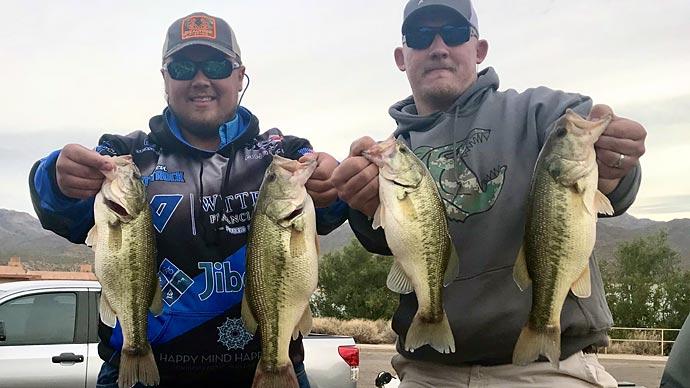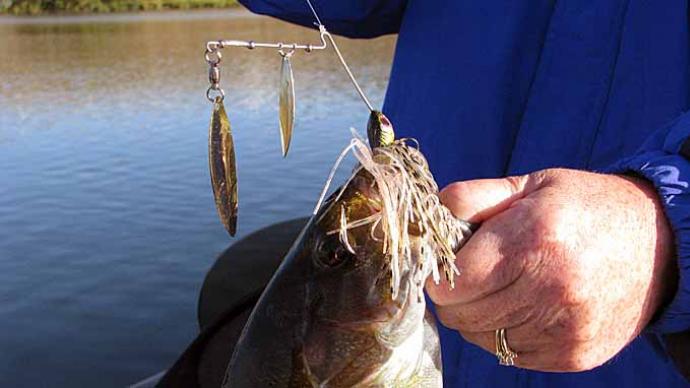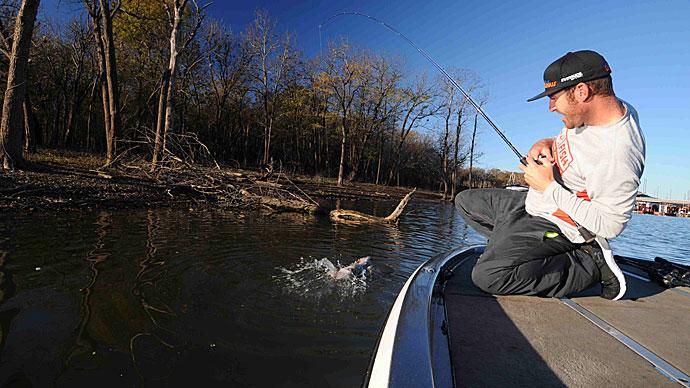
If you think about it, the various types of spinnerbaits are the most versatile of all the crankbaits in that a certain maximum depth does not bind them on the retrieve. The strata of the water that we fish with these plugs depend on how fast or slow we retrieve the baits. We can vary the presentation with one of the baits, but we have three basic types of spinner designs.
Bass fishermen are very familiar with the safety pin type of spinnerbait, and most use the tailspin plug occasionally, but fewer have an inline spinner in their tackle box. Trout and salmon fishermen depend on the plugs in either a smaller or larger version, but often these are not going to make the top five list for bass. One of the possible reasons for this is that the bass size version will usually not produce trophy-size bass. On the other hand, having these available for fishing small ponds or in schooling bass will often significantly change the likelihood of catching fish when they are in a very picky feeding mood.
The Shyster by Luhr Jensen or the Rooster Tail by Worden Lures is significant contributors in this market. The oversized blade on the inline shaft gives a constant vibration on the retrieve and wobbles and rotates on the drop. This should occur with tailspin and safety pin models, but the balance is not as accurate on many, and therefore countdown fishing style is not as effective.
The downside of these plugs is that, unlike the design inherent in the close pin type of spinner, these aren't as weedless on the retrieve. Two of these types of plugs are weedless by design and were made for bass fishing. One of these is still found in some full-service tackle shops. I am qualifying this in this vein because there aren't enough of these around these days, and you aren't usually going to find a Snagless Sally in one of the large superstores where only the latest and hottest lures are on the shelves. These plugs are very specialized but are designed to go through water lilies and vegetation. A deeper version of this style of plug is the old Hawaiian Wiggler. Sorry about this, but this plug is a casualty of company buyouts and a fishing taste that left it as an old-timer. It is fair to say that you will use it only in certain conditions and types of structure, but boy, does it work where the conditions are right.
Another type of spinner that isn't usually thought of for bass is the lead-head plug which has the spinner under the head. The prototype of this type of plug is the Stump Jumper. Crappie and striper fishermen know full well that these are lethal. A friend of mine swears by the striper model for fishing drops along creeks both in summer and in the winter, where bass aggregate and feed on schools of shad. These are also not very weedless but have super action on the fall, both due to the spinner vibration and the pulsation of the skirt. He modifies the bait to make it weedless by using a strip of plastic worm through which he penetrates the eye on one end and impales the barb on the other end. You can also do the same thing by using the right-sized rubber band and looping one end over the eye, and the other end slipped under the barb.
The safety pin version is the most popular spinnerbait when one thinks of bass fishing. But these are not all created equal. Cheaper models are usually made with cheaper hooks and less durable hardware. If you save a few cents in the purchase price, the difference is often proven when you lose a large fish on them; you probably won't consider it had been such a good buy. You can always sharpen the hooks, but if the swivel that holds the blade breaks or the wire fails, it is all over. Most of the better companies on the market consider these things in their quality control. This is why some name brands have a long-term history of selling such products.
Another critical thing with a safety pin type of spinner is balance. It may be helpful to know that you can bend the shaft and make the plug track to the side, but it shouldn't come out of the package. The other critical thing with this type of spinner is whether the blade rotates at a slow speed. Bass often hit the bait on the fall, and your chances of getting their attention are certainly better with a blade that vibrates on the fall at slow speeds than having a plug that only gives off a visual attraction. The whole concept of slow-rolling a spinner is at its most effective use when the blade rotates with the most undersized forward motion.
While all good spinners should have sharp blades, a lighter spinnerbait still takes a long time to drop when fishing 20 feet of water. The ace-in-the-hole with spinnerbaits is that you should be able to cover considerable area in a time-efficient manner. In other words, work an area in the shortest time. The advantage is lost if you spend a lot of time waiting for the drop to get in the strike zone, as occurs in cold water when that zone is often in a deep water structure.
Therefore, the spinnerbait makers have offerings from several companies, including an ounce or even an ounce and one-half spinner. Some have tried to oversize their smaller product lines. This is alright if the balance above still exists. Before you rush into buying a bunch of any brand, observe which one of the heavyweights does the job in shallow water. If the blade is not responsive on the drop while you watch it, things will not improve when it gets on the bottom. An excellent well- balanced spinner, regardless of the size, should let you feel a pulse on the retrieve.
Remember, a spinnerbait is a crankbait, and like all crankbaits, you use it to cover a lot of water and find fish. But also, as with all crankbaits, you have to find the correct retrieve and style of presentation that will be preferred on a given day. Unlike most other crankbaits, spinners can be worked with that presentation at various depths to the bottom if you let them drop to that level before retrieving.
Spinnerbaits, like cranks, are often most productive when you use an erratic retrieve rather than a constant retrieve. Because the blade protects the hook on the retrieve, you should throw them into places that you may not be comfortable with throwing a plug with two sets of treble hooks. To take advantage of the weedless nature, you must control the plug on entry into the water. The blade should hit the water upright, so it immediately starts rotating and will protect the hook. This isn't that hard if you stop the line just before the bait entry into the water and therefore align the plugin those critical last few feet for entry.
There is a trade-out for the more weedless nature of the spinner and that the single hook that the rotating blade can shield is also more likely to lose a fish than the combination of several trebles on other cranks. You may also have days where you will get a lot of short strikes, which will result in missed fish. The only alternative for such conditions is to put a trailer on the hook. This second hook must be controlled, or it will flop around like a disaster waiting to happen as far as foul hooking brush. The easiest way to control the hook is to either run a piece of surgical tubing down the shaft of the trailer or on either side of the eye of the trailer on the shaft of the leading hook. The faster you plan to retrieve a spinner, the more likely you will need a trailer hook.
Bass feed on both sight and vibration. It is a play on these factors where spinnerbaits shine. The darker or more muddy the water, the brighter the skirt should be. Of course, this can apply to low light conditions, such as very early in the morning or late in the evening. More subtle tones or faded colors of the same general colors often work best in clear water or better light conditions. The size of blades also follows the same scheme in that the harder it is for the bass to see the plug, the larger the blade should be. You also need to determine if you want the blade to rotate rapidly on a retrieve, as is often desirable when bass are active feeders, such as warmer water. Or if you want it to slowly rotate if you are fishing in cold water and particularly if you want to slow-roll the bait on the bottom.
The addition of a second blade gives the spinner even more of a vibration effect in the water. However, the rule that you need to follow is to balance the second blade with the overall desired action you want to create with the presentation. If, for example, you want a fast rotation, don't compromise that by altering the bait's balance with the wrong type of second spinner. Both blades should rotate at slow retrieve speeds if you want a slow-rolling plug. Fishermen make better products, and that is why specific matches in size and shape are considered when they offer dual blades.
The colors of skirts are your preference based on what you think the fish are feeding on. The basics are white, yellow, chartreuse, or brown-orange-red. If you fish for bass at night, the skirt's most preferred color is black, or if a very bright night, try white. You may also want to carry some of the spinners with painted blades. These are certainly added color attractants to enhance the bait being seen.
The one remaining bait among the spinners is the tail spinner. If you ask fishermen what this plug is, you will get the answer, "a Little George." These plugs have withstood the run of many similar plugs but still are the dominant ones on the shelf. In part, the logic is the same one I came back to with several of the other spinners BALANCE. The plug has a slight vibration on the retrieve, and the blade rotates at any speed, including the drop. This action is critical since these plugs are usually thrown after schooling fish or as vertical drop baits. The strike on one of these falling baits will often be felt in the form of a "tick' on the line or a sudden weightless feel. In other words, when fishing vertically, watch your line and keep contact on the fall. Here again, most bass will hit a tail spinner on the drop.
Spinnerbaits are one of our most versatile baits, but bass fishermen often become accustomed to using only one model and with a limited type of presentation. When exploited, these plugs will catch fish in all seasons, all types of conditions, and in various water depths.




